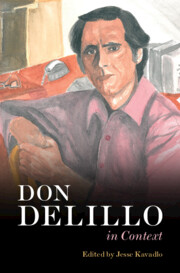Book contents
- Don DeLillo In Context
- Don DeLillo In Context
- Copyright page
- Contents
- Contributors
- Acknowledgments
- Abbreviations
- Introduction: Context, Content, Conflict
- Part I Places
- Part II History and Politics
- Part III Media and Pop Culture
- Part IV Literary Contexts
- Part V Material Contexts
- Chapter 20 Technology
- Chapter 21 The Environment
- Chapter 22 Materiality
- Chapter 23 Death
- Part VI Social and Cultural Constructions
- Part VII Writing and Writers
- Further Reading
- Index
- References
Chapter 22 - Materiality
Violence and the Body
from Part V - Material Contexts
Published online by Cambridge University Press: 19 May 2022
- Don DeLillo In Context
- Don DeLillo In Context
- Copyright page
- Contents
- Contributors
- Acknowledgments
- Abbreviations
- Introduction: Context, Content, Conflict
- Part I Places
- Part II History and Politics
- Part III Media and Pop Culture
- Part IV Literary Contexts
- Part V Material Contexts
- Chapter 20 Technology
- Chapter 21 The Environment
- Chapter 22 Materiality
- Chapter 23 Death
- Part VI Social and Cultural Constructions
- Part VII Writing and Writers
- Further Reading
- Index
- References
Summary
This chapter ranges widely through the decades of DeLillo’s output, drawing out DeLillo’s prioritizing of the visceral over the cerebral, and offering a counter to the wealth of existing criticism that places DeLillo in conversation with abstract, theoretical concepts.
- Type
- Chapter
- Information
- Don DeLillo In Context , pp. 207 - 216Publisher: Cambridge University PressPrint publication year: 2022



